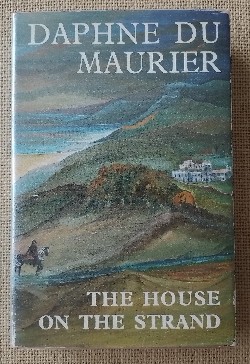The House on the Strand by Daphne du Maurier, reviewed by Eva Leung

An image of a UK first edition of The House on the Strand
Genre: Time-Travel Science Fiction, Fantasy, Gothic Historical fiction, Contemporary Fiction
Original Publication: 1969
In between jobs and trapped in a dull marriage with an American wife and two stepsons, Dick (Richard) Young agrees to help Professor Magnus Lane, a friend from his university days, with a time-travel experiment: He has his conscience transported to the fourteenth century by taking a hallucinogenic drug that Magnus has developed. Invisible to the people in the past world who are not aware of his ghostly presence, Dick is unable to interact with them and hence becomes a passive eavesdropper in time. There, following a steward named Roger Kylmerth, Dick bears witness to the complicated relations, adulteries, murders, conflicts and harmony, life and death of the aristocrats, and finds himself infatuated with a certain Lady Isolda Carminowe. As Dick becomes increasingly obsessed with the other world, he journeys there more and more frequently. But then the two realities begin to mergeÖ and tragedy strikes.
As scholar Nina Auerbach said, The House on the Strand is du Maurierís forgotten novel. Despite the fast-paced plot, intriguing storyline and vivid characters, the world remains oblivious to du Maurierís genius in producing a time travel novel. In contrast, it has done multiple remakes of movies and dramas of her most famous work, Rebecca, which is still popular after eight decades, with the newest adaptation just coming out in 2020.
But rereading this book for, I lost count of how many times, I continue to be fascinated by Dickís eye-witness account (not adventures) in the other world and wish to join his escape into it. Sometimes I find myself trying to rush through the parts of Dickís narratives in the present world to get to the parts of his experiences in the 14th century. In this unusual fantasy novel, the time traveller is not a participant in the world he visits, where the people in the past are totally ignorant of his presence, for any contact with them would hurt Dick and shove him back to the present. The characters in Dickís 14th-century world are also real people who existed in history, so du Maurier did what she usually did with her other novels like The Kingís General (1946), which was to undertake meticulous research to write about these actual historical figures in her book. This novel demonstrates again du Maurierís superb skills in weaving fact and fiction.
This is Daphne du Maurierís penultimate novel, and it is remarkable that, towards the end of her career, she was still exploring new genres for her works. She wrote Split Second as a time-slip short story, but The House on the Strand remains her only time-travel novel, and the result of this experimentation is dazzling.
© Eva Leung August 2024.
